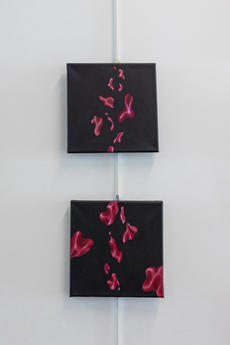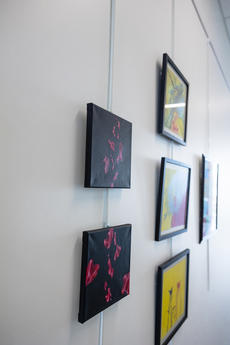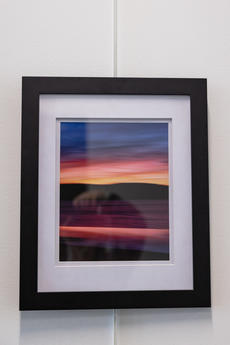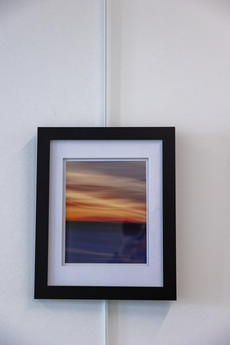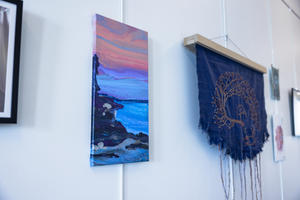Student, faculty embrace artistic side in Health Sciences exhibition

Three members of the School of Dentistry community participated in the University of Minnesota’s inaugural Health Sciences Spring Art Exhibition this April.
Hosted by Community Arts @ Health Sciences, the Spring Exhibition includes artistic pieces from faculty, staff and students. Out of 53 entries, more than 20 works were accepted and put on display in the Health Sciences Education Center in mid-April. Two School of Dentistry faculty and one student were chosen as part of the exhibition.
Community Arts @ Health Sciences seeks to “inspire and enable students, faculty, staff, and community members to engage with art and with each other, while highlighting the impactful ways that art and science inform one another,” according to their website.
Get to know the art and artists represented from the School of Dentistry.
Suspended
Eurphrosyne Daoutidou
DDS Class of 2025
“I bounce around from different art styles, from portraiture and still life to more surrealistic themes, many of which include dripping or melting objects or faces. In this piece I wanted to play with form, value, and movement to create a suspended fluidity that combined artistic elements with biological visuals.”
Why did you decide to participate in the exhibition?
“I think oftentimes there tends to be a split between what people consider “science minds”and artistic ones, and I wanted to showcase that this separation is not necessarily accurate. I did my undergrad here at the U and minored in art, participating in some exhibitions during that time, but this time around being able to share my art with the health science community is a special intersection of passions.”
How do you believe art and dentistry intersect?
“Dentistry and art are both creative processes reliant on a mental and physical connection, starting with thought and working through the hands. Dentistry can incorporate structured aspects of art, for example a cavity prep having specific shapes, angles, and dimensions. It also has an esthetic touch; in building up a restoration, the process of forming realistic tooth anatomy can feel very sculptural. Both fields include visual composition.”
Frozen Sunset and Blue Hour Blur
Jeffrey Karp, DMD, MS
Clinical associate professor of pediatrics & director, Pediatric Dentistry Residency Program
“Frozen Sunset and Blue Hour Blur are two photographs from my most recent project and photography book called Invisibility: weather hidden in plain sight. These photographs were made standing on the beach viewing Lake Independence (Maple Plain, MN) during two beautiful winter sunsets. The photographs were made using a slow shutter time and intentional camera movement.”
Why did you decide to participate in this exhibition?
“Photography became a hobby and passion of mine starting in the summer of 2016. For the past 7 years, I have shared my photography and built a following on Instagram (@jeffreymkarp) and other venues. In the last several months, I have started to pursue more opportunities to share my photography in printed form, through making photography books and fine art prints along with entering my photographs into competitions and exhibitions. I currently have a piece called “Cumulus” on display as part of the Diptych exhibition at the Praxis Photo Arts Center in Minneapolis.
When I saw the call for submissions, I was excited to apply. This exhibition gives me an opportunity to share my art with our health sciences community and to better understand the steps needed to have my photographs printed, framed and displayed as physical works. I look forward to viewing the exhibition and seeing the works of other artists including faculty and students from our school.”
How do you believe art and dentistry intersect?
“Art, creative expression, and storytelling humanize the healthcare experience for patients and their providers. Art provides a respite from the stresses of healthcare and the busyness of life. Photography and art allow me to slow down and see the beauty in fleeting moments around me, be open to different perspectives, and unlock a creative mindset in everything that I do.”
Tranquility
Natalie Peterson, DDS
Clinical associate professor of comprehensive care
“This piece is a landscape pour painting. I used a photo of a sunrise at a lake as inspiration and mixed parts to mimic the colors in the photo. I poured the paint in sections to follow the gradations of color in the photo, creating an abstract landscape painting. I couldn’t paint a thing with a brush if you paid me a million dollars, but I like being able to do pour paintings because they’re more abstract and allow me to use colors that I like.”
Why did you decide to participate in this exhibition?
“I submitted a piece because I thought, why not? I have nothing to lose by trying. I used to crochet, but over the years that has gotten too hard on my hands to keep up with it. I started dot painting and jewelry making before COVID, and during the COVID shutdown I started doing acrylic pour painting and it was really fun. I like to have something non-dental to do when I get home that is creative and fun and takes my mind off work. It's important to have outlets like that.”
How do you believe art and dentistry intersect?
“I think you do need to be a little bit of an artist to be a dentist, in that you have to sometimes think spatially and abstractly to recreate things that are missing and visualize what you want to create, and also build it with the materials that we use. There's definitely some overlap there. I never became interested in creative hobbies until several years after dental school though.”
